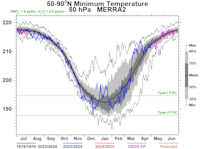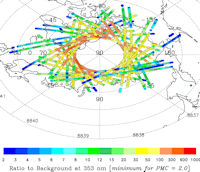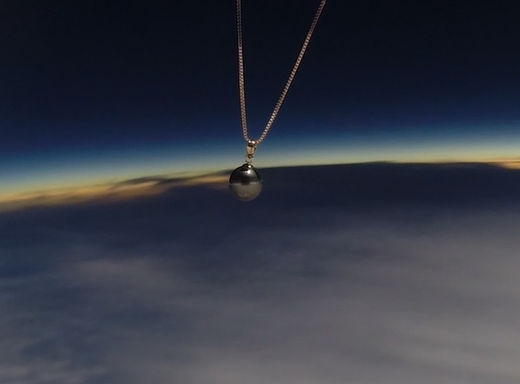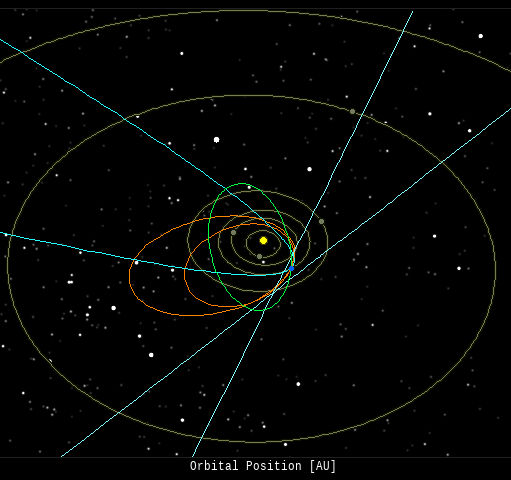 | | | Switch to: Europe, USA, New Zealand, Antarctica Credit: NOAA/Ovation  Planetary K-index Planetary K-index
Now: Kp= 2.67 quiet
24-hr max: Kp= 2.67 quiet
explanation | more data
Interplanetary Mag. Field
Btotal: 5.24 nT
Bz: -3.38 nT south
more data: ACE, DSCOVR
Updated: Today at 1147 UT  Coronal Holes: 28 Jul 24 Coronal Holes: 28 Jul 24 
There are no significant coronal holes on the Earthside of the sun. Credit: SDO/AIA  Polar Stratospheric Clouds
Colorful Type II polar stratospheric clouds (PSC) form when the temperature in the stratosphere drops to a staggeringly low -85C. NASA's MERRA-2 climate model predicts when the air up there is cold enough: 
On July 27, 2024, the Arctic stratosphere is much too warm for Type II polar stratospheric clouds. | more data. Noctilucent Clouds
They're back! The northern season for NLCs is underway. The first clouds were detected inside the Arctic Circle on May 25, 2024, by the NOAA 21 satellite. The clouds have since spread, and now observers are seeing from the ground as well:

Updated: July 25, 2024
An instrument onboard NOAA 21 (OMPS LP) is able to detect NLCs (also known as "polar mesospheric clouds" or PMCs). In the daily map, above, each dot is a detected cloud. As the season progresses, these dots will multiply in number and shift in hue from blue to red as the brightness of the clouds intensifies.
 SPACE WEATHER
NOAA Forecasts | | Updated at: 2024 Jul 28 2200 UTC FLARE | 0-24 hr | 24-48 hr | CLASS M | 75 % | 70 % | CLASS X | 20 % | 20 % |  Geomagnetic Storms: Geomagnetic Storms:
Probabilities for significant disturbances in Earth's magnetic field are given for three activity levels: active, minor storm, severe storm Updated at: 2024 Jul 28 2200 UTC Mid-latitudes | 0-24 hr | 24-48 hr | ACTIVE | 35 % | 25 % | MINOR | 15 % | 35 % | SEVERE | 01 % | 35 % | High latitudes | 0-24 hr | 24-48 hr | ACTIVE | 10 % | 05 % | MINOR | 25 % | 15 % | SEVERE | 50 % | 79 % | | | |  | | | | | | | | | | | This is an AI Free Zone! Text created by Large Language Models is spreading rapidly across the Internet. It's well-written, artificial, frequently inaccurate. If you find a mistake on Spaceweather.com, rest assured it was made by a real human being. | | | CANNIBAL CME ALERT: A series of M-class flares over the weekend hurled multiple CMEs toward Earth, as many as four or five. According to a NOAA model, the first two CMEs are merging to form a single Cannibal CME. Strong G3-class geomagnetic storms are possible when it reaches Earth on July 30th. Subscribers to our Space Weather Alert Service will receive an instant text message when the CME arrives. Bonus: Watch NOAA's animated forecast model of the first two CMEs merging to form a Cannibal. The Cannibal CME is clearing the way for perhaps 2 to 3 more CMEs following behind it. SOHO coronagraphs show a wagon-train of clouds leaving the sun on July 28th: 
The first and most potent of these CMEs was launched by an M9.9-class solar flare from sunspot complex AR3765-67 on July 28th (0157 UT): movie. The CME will fly into a void created by the earlier Cannibal CME. With little interplanetary material to slow it down, the storm cloud should reach Earth no later than July 31st. A preliminary NASA model supports this forecast. Even if the Cannibal CME fails to spark a strong geomagnetic storm on July 30th, the arrival of more CMEs on July 31st could push storm levels to category G3 (Strong) or beyond. This would set the stage for mid-latitude auroras visible from Europe and the USA. CME impact alerts: SMS Text Realtime Space Weather Photo Gallery
Free: Spaceweather.com Newsletter TAHITIAN BLACK SOLAR ECLIPSE PEARL: It came from Tahiti, and now it has touched the shadow of the Moon. On April 8, 2024, the students of Earth to Sky Calculus launched this black pearl into a total eclipse of the sun over Texas. Riding on a cosmic ray research balloon, the pearl was 86,564 feet high when lunar darkness swallowed it for 3 minutes 45 seconds: 
You can have it for $299.95. Measuring 9 mm in diameter, this genuine Tahitian pearl has an 18K rose gold clasp and is suspended from a matching 925 Sterling Silver chain. It comes with a greeting card showing the pearl in flight and telling the story of its journey to the edge of space during the 2024 total eclipse. Far Out Gifts: Earth to Sky Store
All sales support hands-on STEM education
Realtime Aurora Photo Gallery
Free: Spaceweather.com Newsletter
Realtime Comet Photo Gallery
Free: Spaceweather.com Newsletter
Realtime Noctilucent Cloud Photo Gallery
Free: Spaceweather.com Newsletter Every night, a network of NASA all-sky cameras scans the skies above the United States for meteoritic fireballs. Automated software maintained by NASA's Meteoroid Environment Office calculates their orbits, velocity, penetration depth in Earth's atmosphere and many other characteristics. Daily results are presented here on Spaceweather.com. On Jul 27, 2024, the network reported 21 fireballs.
(20 sporadics, 1 Perseid)  In this diagram of the inner solar system, all of the fireball orbits intersect at a single point--Earth. The orbits are color-coded by velocity, from slow (red) to fast (blue). [Larger image] [movies] Potentially Hazardous Asteroids ( PHAs) are space rocks larger than approximately 100m that can come closer to Earth than 0.05 AU. None of the known PHAs is on a collision course with our planet, although astronomers are finding new ones all the time. On July 28, 2024 there were 2349 potentially hazardous asteroids.
 | Recent & Upcoming Earth-asteroid encounters: | Asteroid | Date(UT) | Miss Distance | Velocity (km/s) | Diameter (m) | | 2024 NH | 2024-Jul-23 | 13.1 LD | 5.5 | 29 | | 2024 LY2 | 2024-Jul-23 | 12 LD | 7.8 | 93 | | 2024 OA | 2024-Jul-24 | 2.3 LD | 13.3 | 30 | | 2011 MW1 | 2024-Jul-25 | 10.1 LD | 8 | 120 | | 2024 NV1 | 2024-Jul-25 | 14.1 LD | 10.2 | 33 | | 2024 MH1 | 2024-Jul-26 | 4.7 LD | 5.8 | 29 | | 2011 AM24 | 2024-Jul-26 | 16.8 LD | 6.2 | 281 | | 2024 NZ1 | 2024-Jul-28 | 19.5 LD | 12.7 | 57 | | 523664 | 2024-Jul-28 | 14.9 LD | 23.7 | 680 | | 2024 NS1 | 2024-Aug-02 | 5.3 LD | 7.6 | 48 | | 2020 PN1 | 2024-Aug-02 | 18 LD | 5.5 | 29 | | 2024 OC | 2024-Aug-04 | 19.4 LD | 10 | 132 | | 2023 HB7 | 2024-Aug-05 | 14.7 LD | 6.1 | 32 | | 2017 TU1 | 2024-Aug-05 | 10.1 LD | 10.1 | 22 | | 2024 KH3 | 2024-Aug-10 | 14.6 LD | 11.4 | 191 | | 2021 GY1 | 2024-Aug-16 | 17.7 LD | 6.3 | 59 | | 2024 JV33 | 2024-Aug-19 | 12 LD | 11.1 | 205 | | 2022 BF2 | 2024-Aug-19 | 19.7 LD | 16.4 | 91 | | 2020 RL | 2024-Aug-27 | 12.2 LD | 8.2 | 34 | | 2021 RA10 | 2024-Aug-28 | 6.8 LD | 4.9 | 29 | | 2012 SX49 | 2024-Aug-29 | 11.2 LD | 4.3 | 20 | | 2016 RJ20 | 2024-Aug-30 | 18.3 LD | 14.8 | 68 | | 2021 JT | 2024-Sep-01 | 16.4 LD | 8.2 | 12 | | 2021 RB16 | 2024-Sep-02 | 12.3 LD | 8.4 | 15 | | 2007 RX8 | 2024-Sep-02 | 18.5 LD | 7 | 44 | | 2022 SR | 2024-Sep-07 | 9.1 LD | 6.3 | 42 | | 2023 SP2 | 2024-Sep-09 | 15.3 LD | 4.2 | 8 | | 2016 TU19 | 2024-Sep-11 | 13.2 LD | 10.1 | 47 | | 2019 DJ1 | 2024-Sep-15 | 10.4 LD | 4.9 | 15 | | 2013 FW13 | 2024-Sep-18 | 8.5 LD | 15.6 | 162 | | 2022 SW3 | 2024-Sep-19 | 6.8 LD | 9.2 | 37 | | 2015 SH | 2024-Sep-19 | 11.6 LD | 5.9 | 9 | | 2023 RX1 | 2024-Sep-20 | 10.1 LD | 1.1 | 3 | | 2018 VG | 2024-Sep-20 | 13.4 LD | 7.3 | 12 | | 2020 GE | 2024-Sep-24 | 1.7 LD | 2.2 | 8 | Notes: LD means "Lunar Distance." 1 LD = 384,401 km, the distance between Earth and the Moon. 1 LD also equals 0.00256 AU. | | Cosmic Rays in the Atmosphere | SPACE WEATHER BALLOON DATA: Almost once a week, Spaceweather.com and the students of Earth to Sky Calculus fly space weather balloons to the stratosphere over California. These balloons are equipped with sensors that detect secondary cosmic rays, a form of radiation from space that can penetrate all the way down to Earth's surface. Our monitoring program has been underway without interruption for 7 years, resulting in a unique dataset of in situ atmospheric measurements. Latest results (July 2022): Atmospheric radiation is decreasing in 2022. Our latest measurements in July 2022 registered a 6-year low: 
What's going on? Ironically, the radiation drop is caused by increasing solar activity. Solar Cycle 25 has roared to life faster than forecasters expected. The sun's strengthening and increasingly tangled magnetic field repels cosmic rays from deep space. In addition, solar coronal mass ejections (CMEs) sweep aside cosmic rays, causing sharp reductions called "Forbush Decreases." The two effects blend together to bring daily radiation levels down. .Who cares? Cosmic rays are a surprisingly "down to Earth" form of space weather. They can alter the chemistry of the atmosphere, trigger lightning, and penetrate commercial airplanes. According to a study from the Harvard T.H. Chan school of public health, crews of aircraft have higher rates of cancer than the general population. The researchers listed cosmic rays, irregular sleep habits, and chemical contaminants as leading risk factors. A number of controversial studies (#1, #2, #3, #4) go even further, linking cosmic rays with cardiac arrhythmias and sudden cardiac death. Technical notes: The radiation sensors onboard our helium balloons detect X-rays and gamma-rays in the energy range 10 keV to 20 MeV. These energies span the range of medical X-ray machines and airport security scanners. Data points in the graph labeled "Stratospheric Radiation" correspond to the peak of the Regener-Pfotzer maximum, which lies about 67,000 feet above central California. When cosmic rays crash into Earth's atmosphere, they produce a spray of secondary particles that is most intense at the entrance to the stratosphere. Physicists Eric Regener and Georg Pfotzer discovered the maximum using balloons in the 1930s and it is what we are measuring today. | | The official U.S. government space weather bureau | | | The first place to look for information about sundogs, pillars, rainbows and related phenomena. | | | Researchers call it a "Hubble for the sun." SDO is the most advanced solar observatory ever. | | | 3D views of the sun from NASA's Solar and Terrestrial Relations Observatory | | | Realtime and archival images of the Sun from SOHO. | | | information about sunspots based on the latest NOAA/USAF Active Region Summary | | | current counts of failed and deployed Starlink satellites from Jonathan's Space Page. See also, all satellite statistics. | | | Authoritative predictions of space junk and satellite re-entries | | | from the NOAA Space Environment Center | | | fun to read, but should be taken with a grain of salt! Forecasts looking ahead more than a few days are often wrong. | | | from the NOAA Space Environment Center | | | the underlying science of space weather |  | Got a chipped or cracked windshield that prevents you from seeing space weather events while driving? Get windshield replacement from SR Windows & Glass with free mobile auto glass service anywhere in the Phoenix area. |  | Marketing yourself on YouTube is hard without real organic views on your videos. You can buy organic YouTube views from and enjoy social boosting that is actually real. Highly recommended! |  | BestCSGOGambling is the best site for everything related to CSGO gambling on the web | | | These links help Spaceweather.com stay online. Thank you to our supporters! | | | | | | | | |  | |  |   | ©2021 Spaceweather.com. All rights reserved. This site is penned daily by Dr. Tony Phillips. | |

